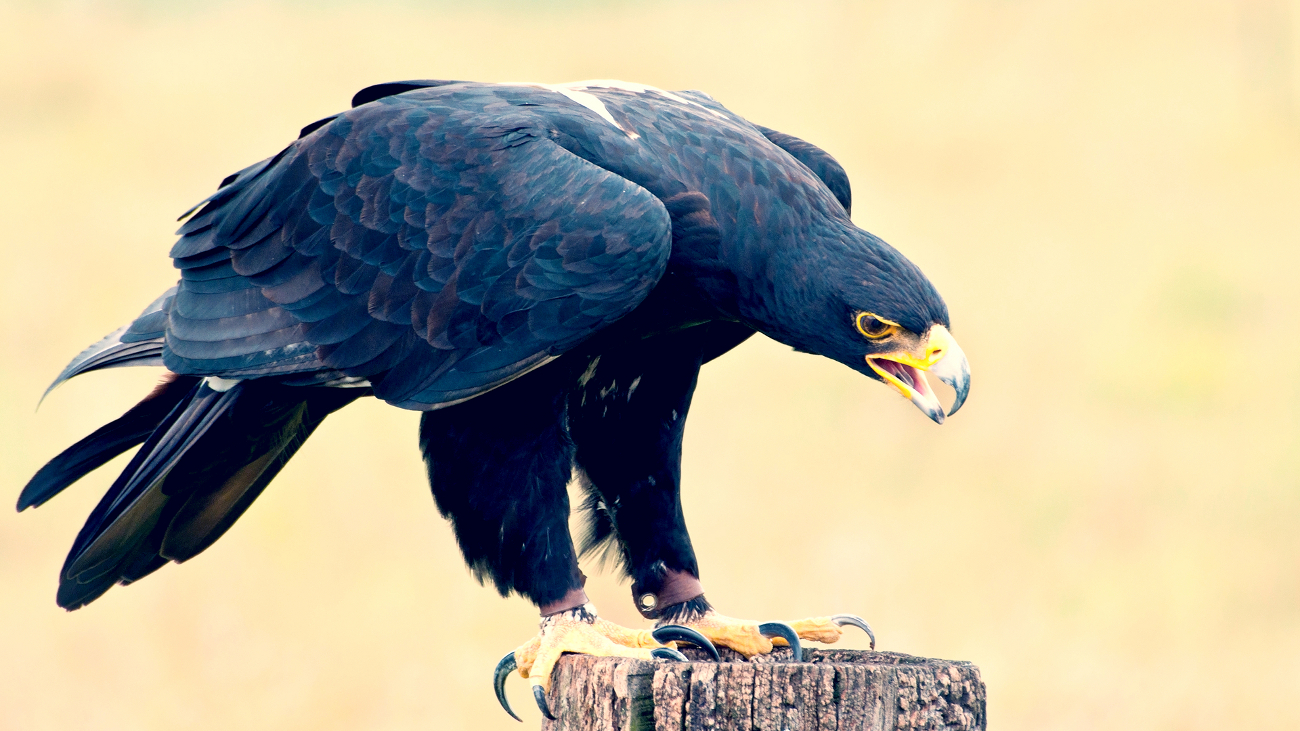- Home
- Conservancy
- Verreaux s eagle
Description
Verreaux's eagle is a very large eagle. It measures 75 to 96 cm (30 to 38 in) long from the bill to the tip of the tail, making it the sixth longest eagle in the world. Males can weigh 3 to 4.2 kg (6.6 to 9.3 lb) and the larger females weigh 3.1 to 7 kg (6.8 to 15.4 lb). The average weight is approximately 4.19 kg (9.2 lb). It is the seventh or eighth heaviest living eagle in the world. In average mass and overall weight range, if not linear measurements, the Verreaux's is very similar in size to its occasional competitor, the martial eagle, which is regularly titled the largest of the African eagle.
It also rivals the martial and golden eagles as the largest extant member of the "booted eagle" clan. It has a wingspan of 1.81 to 2.3 m (5 ft 11 in to 7 ft 7 in). The wing chord of the male is 56.5 to 59.5 cm (22.2 to 23.4 in) and that of the female is 59 to 64 cm (23 to 25 in). Among other standard measurements in the Verreaux's eagles, both sexes measure 27.2 to 36 cm (10.7 to 14.2 in) in tail length and 9.5 to 11 cm (3.7 to 4.3 in) in tarsus length. Other than the female’s slight size advantage, adult males and females are physically indistinguishable from each other. Adult Verreaux's eagles are mostly jet-black in color. The yellow coloration of the cere (the bill is gun-metal grey), eye-ring and “eye-brows”, all stand out in contrast to the black plumage. Even more prominent on flying birds when seen from above is the white on the back, rump and upper-tail coverts and part of the scapulars, which forms a V-shaped patch, although this feature is partially obscured in perched birds.
Adults also have conspicuous white windows on the wing quills at the carpal joint (at the base of the primaries) when seen flying both from above and below. The bill is stout, the head is prominent on the relatively long neck and the legs are fully feathered.
Juvenile and immature plumages differ markedly from the plumage of adults. They are overall a dark brown color. Immatures have a strongly contrasting golden crown and a rufous or ginger nape and mantle. They have small white streaks on the forehead and black on their cheeks. The throat is dark streaked, the lower throat is pale brown and the upper-chest is brown. The rest of the underside is brown but for a blackish-blotched rufous to cream-colored abdomen and lightly marked creamy thighs and legs. The feathers of the upper-tail and upper-wing coverts are brown with white streaks in young birds, while the other tail and wing quills are nearly black.
The wing quills when seen from below in flight show considerable whitish mottling, with more extensive white than is typically seen in adult plumages. The immature has a dark brown iris and yellowish feet. Black feathers increase from 2 to 5 years of age amongst a scattering of brown-tipped feathers, though the contrasting creamy trousers are maintained through the 3rd year. By the 4th year, they look dark grey-brown with a buff-patch on the nape and mottling of retained brownish feathers. At the end of the subadult phase at around 5 years of age, the plumage is practically indistinguishable from the adult. Full adult plumage is probably attained in 5 to 6 years.
The Verreaux's eagle is essentially unmistakable, especially in adulthood. No other black-colored raptor in its range approaches this species’ large size, nor possesses its distinctive patterns of white. The golden eagle is of similar size or marginally larger size and the two species are the heaviest living Aquila species and measure only marginally less than the slightly lighter-weight Australasian wedge-tailed eagle in total wing and bill-to-tail length. While the juvenile Verreaux's eagle is quite different from the adult's, its plumage is no less distinctive.
No other accipitrid shares the mottled brownish body, blackish wings with large white patches or contrasting whitish, rufous and golden color around the head and neck as that of an immature eagle. The flight profile of Verreaux's eagle is also distinctive, as it is the only Aquila species other than the golden eagle to soar in a pronounced dihedral, with the wings held slightly above the back and primaries upturned at the tip to make a V shape. In the Bale Mountains of Ethiopia and possibly in some parts of the Arabian Peninsula and the southwestern edge of the Middle East, the ranges of the golden and Verreaux's eagles overlap, but the golden is a mostly brown bird and shares none of the Verreaux's black plumage.
The immature golden eagle has white patches on its underwing as do Verreaux's but they are less extensive than those of the latter species. The wing shape also differs from the golden, as the Verreaux's eagle has very broad outer secondaries and a relatively narrow pinch at the base of the primaries, whereas the tapering of a golden eagle’s wing is more gradual. The Verreaux's eagle wings have variously been described as paddle, spoon or leaf shaped. Imperial eagles are another improbable but possible source of confusion, since they too have white markings on their wing coverts, but are totally different in flight profile (much flatter winged) and overall coloration (dark brown).
Fun Facts
This species is largely silent, though is arguably a stronger vocalist than its close cousin, the golden eagle. Chicking and chirruping sounds like that of a young turkey or francolin, pyuck, have been heard in various contexts, such as pairs being reunited. More striking sounds are loud, ringing whaeee-whaeee, heeeee-oh or keeooo-keeooo calls used as contact calls or during intruder chases. Various screams, barks, yelps and mews have been heard to be issued at potential mammalian predators. The young emits feeble chirps at first, later more likely to cluck like the adults.
